Categories
Change Password!
Reset Password!


A randomized controlled clinical trial was conducted to assess the effectiveness of Ibuprofen (a non-steroidal anti-inflammatory drug [NSAID]) versus acupressure in relieving pain following the placement of elastomeric orthodontic separators.
For mitigating orthodontic pain following the insertion of separators, both Ibuprofen and acupressure are effective.
A randomized controlled clinical trial was conducted to assess the effectiveness of Ibuprofen (a non-steroidal anti-inflammatory drug [NSAID]) versus acupressure in relieving pain following the placement of elastomeric orthodontic separators.
Overall, 75 orthodontic subjects between the ages of 12 and 16 were randomized into 3 groups: one group received a 400 mg dose of Ibuprofen orally, another group was given acupressure therapy, and the third group received no pain relief treatment. Pain levels were assessed using visual analog scales (VAS) at various time intervals (4, 10, 18, 24 hours, and 1 week). The equivalence margin was set at 10 mm.
Across all time intervals, the control group consistently reported the greatest levels of pain. In the case of the Ibuprofen and acupressure groups, there were no significant differences in pain levels following 4 hours, 18 hours, and 1 week. However, post 10 hours, there was a notable distinction: the control group showed no significant difference compared to the acupressure group, but the Ibuprofen group exhibited substantially reduced pain.
Within the acupressure group, the peak pain was observed at the 10-hour mark, followed by a gradual drop over time, with the lowest pain reported after 1 week. In contrast, both the control and Ibuprofen groups experienced their highest pain levels after 4 hours, with the pain gradually diminishing over time, reaching its lowest point following 1 week (Figure 1).

Participants who used either Ibuprofen (pharmacological intervention) or acupressure (nonpharmacological intervention) did not show a noteworthy disparity in their perception of pain.
Interestingly, both of these groups reported considerably lower levels of pain in comparison to the control group across the majority of the assessed time intervals. These findings provide evidence supporting the pain-relieving effectiveness of the acupressure method.
Journal of Orofacial Orthopedics
Acupressure versus NSAID for relief of orthodontic pain: A randomized controlled clinical trial
Elshehaby M et al.
Comments (0)